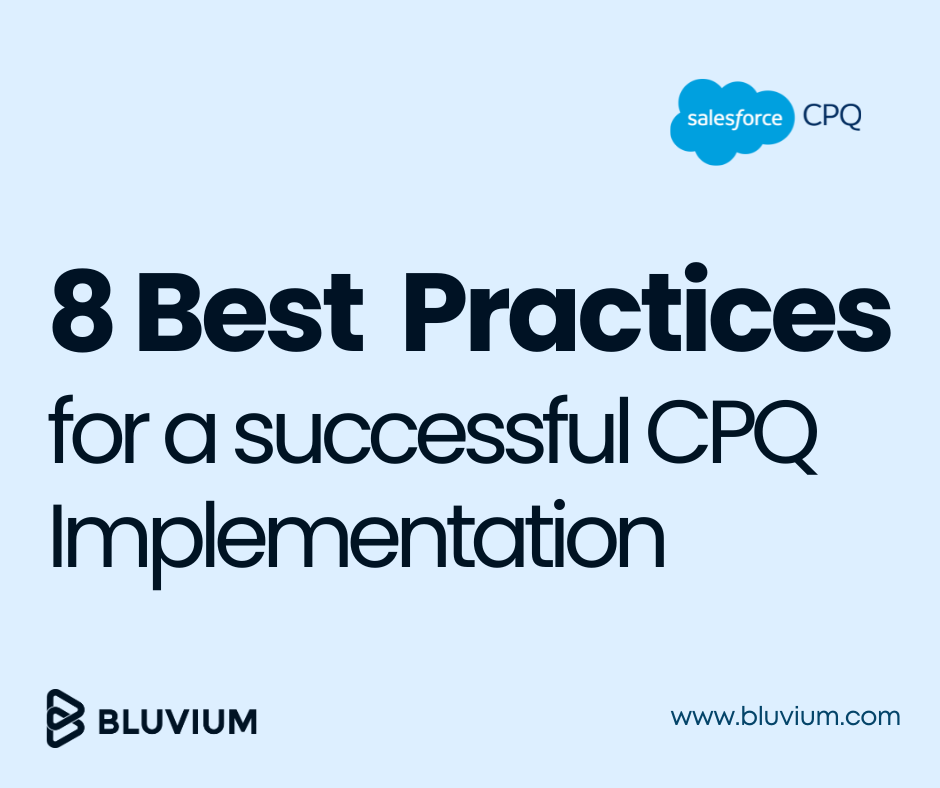
Salesforce CPQ (Configure, Price, Quote), part of the Revenue Cloud, is a powerful tool that can significantly streamline your sales process. It delivers accurate, customized quotes quickly, helping prospects understand pricing with transparency, which accelerates their buying decision. Plus, it saves your sales team from the tedious work of manual quoting, freeing them to focus on higher-value tasks.
That said, transitioning from a manual process to CPQ can seem daunting at first. Teams need time to learn the new system, ensure data accuracy, and integrate it with existing workflows. But with careful planning and the right strategy, the transition doesn’t have to be difficult. Here are ten tips to ensure your Salesforce CPQ implementation runs smoothly.
1. Identify Your Key Stakeholders
Before diving into the implementation, make sure you know who the key players are. Your sales team is likely the most impacted, as they’ll be the ones using CPQ daily to manage pricing and quotes. Customer success stories and product demos can help get them excited about the change.
2. Document Your Current Quoting Process
A successful CPQ implementation starts with understanding your current quoting workflow. Talk to stakeholders, especially your sales and revenue teams, to identify existing pain points. What takes too long? Where are the bottlenecks? Use these insights to establish clear goals for your new system.
3. Set Clear Project Goals
Bring all stakeholders together for a workshop to set expectations and project goals. Be mindful that different groups may have different priorities. Your revenue team might focus on maximizing sales, while your Salesforce team is concerned with smooth technical implementation. Make sure each voice is heard and incorporate their concerns into your project objectives.
4. Prepare Your CPQ Data
Accurate and relevant data is the backbone of any CPQ system. Start by cleaning up your “master data” — like product info and pricing — and migrate only what’s needed. This will streamline the implementation process and ensure accurate, efficient quoting. Work closely with your growth team to define pricing rules that align with your business goals.
5. Integrate with Third-Party Apps
Your Salesforce CPQ system likely won’t exist in a vacuum. Look at your current tech stack, including third-party apps like customer engagement tools or version control systems, and consider how they will integrate with CPQ. Ensuring seamless integration will save time and reduce friction across teams.
6. Establish a Center of Excellence
Creating a Center of Excellence (CoE) can make your CPQ implementation smoother and more efficient. This team can lead training, share lessons learned, and help others avoid common pitfalls. A CoE doesn’t need to be perfect — in fact, sharing what didn’t work can be just as valuable for future projects.
7. Embrace Dev Ops & Master CPQ Deployments
A DevOps approach can simplify your CPQ implementation and deployment. By focusing on continuous improvement, you can gradually enhance your process without overwhelming your team. Performance testing along the way will allow you to catch any issues early, while promoting open communication and iterative development.CPQ is beloved by sales teams, but it can be complex for Salesforce admins. To prevent deployment headaches, make sure to manage dependencies carefully and maintain visibility over deployments. Clear communication between teams will ensure a smooth rollout and avoid unnecessary mistakes.
8. Track Your Success
It’s essential to set measurable goals to track the success of your CPQ implementation. For example, you might aim to increase quote generation speed by 40% in six months, or boost upselling by 30% in a year. Regularly check progress and share the wins to keep everyone invested in the project’s success.
Conclusion
Salesforce CPQ has the potential to revolutionize your sales process, saving time, increasing accuracy, and boosting growth. But the key to success lies in careful planning, cross-team collaboration, and attention to detail. By following these best practices, you can ensure that your CPQ implementation is smooth, scalable, and delivers the value your business needs.Ultimately, a well-executed CPQ system will not only streamline operations but also empower your team to focus on what they do best — selling.





